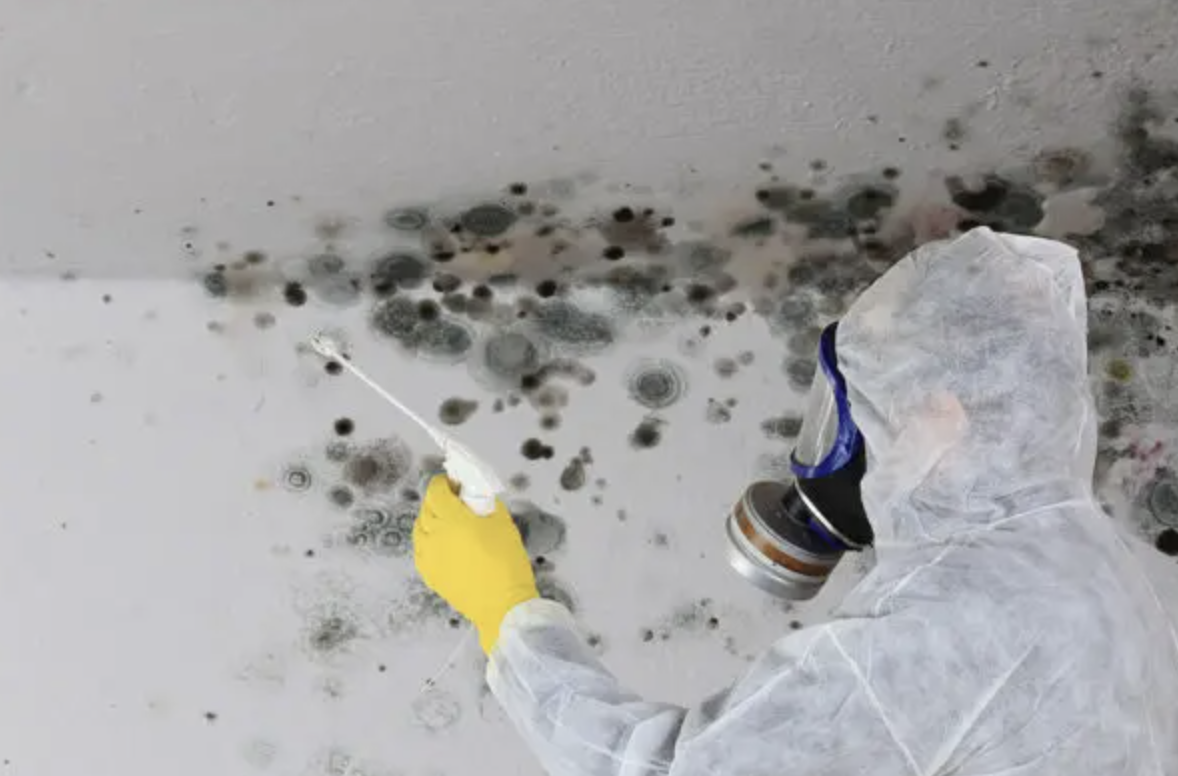Article by Joshua Kent
Moisture Master Pros Owner
What is Mold?
Mold is a type of fungus that can be found both indoors and outdoors. It reproduces through tiny spores that can be found floating in the air. When these spores land on a damp surface, they can begin to grow and spread. Left unchecked, mold can cause significant damage to your home and even pose health risks to you and your family.

What are the different types of mold?
There are many different types of mold spores, and they can be classified into several groups based on their characteristics and the conditions under which they grow(indoor mold growth vs. outdoor mold growth).
The most common indoor molds include:
- Aspergillus: This group of molds can be found indoors and outdoors. Some species can produce toxic compounds known as mycotoxins, which can be harmful to humans.
- Cladosporium: This is another common type of mold that can be found indoors and outdoors. It can grow on various surfaces, including wood, paper, and fabrics.
- Penicillium: Commonly found in damp indoor environments, these molds can cause allergic reactions and produce mycotoxins.
While the molds listed above are commonly found indoors, other types of mold may also be present in your home, though they may not be as frequently encountered.
These include:
- Stachybotrys: Commonly known as “black mold,” Stachybotrys can produce toxic fumes and grow on materials like cellulose-based products such as drywall, insulation, or paper.
- Alternaria: This mold is commonly found in damp outdoor environments but can also grow indoors. It can cause allergic reactions and can also be a potential source of hay fever.
- Fusarium: This type of mold is commonly found in damp indoor environments, and it can grow on a variety of materials, including wood, carpet, and insulation.
These are just a few examples of the many types of mold that can be found in homes. Keep in mind that mold can come in many different colors, such as black, white, green, orange, and many other variations, and just because it looks a specific color doesn’t mean it’s dangerous or toxic; it’s more important to focus on the quantity and location of mold in your home. It’s always a good idea to consult a professional if you suspect mold in your home.

Health Effects of mold exposure
Mold exposure can negatively affect your health, depending on the type of mold, the duration of exposure, and your sensitivity. In some people, mold exposure can cause respiratory problems, such as coughing, sneezing, and difficulty breathing. It can also cause eye, nose, throat, and skin irritation in some people.
People with mold allergies or asthma may be more sensitive and experience more severe symptoms. Additionally, exposure to certain mold types can cause more severe health problems like fever, shortness of breath, chest tightness, and neurological symptoms. In rare cases, exposure to certain types of mold can also lead to infection.
Long-term mold exposure can also lead to chronic health problems such as fatigue, headaches, and memory loss.

Dealing With Mold in Your Home
Mold is a common problem many homeowners face, but understanding why it’s growing in your home is crucial for effectively dealing with it. Mold needs three things to grow: moisture, warmth, and a food source. Moisture can come from various sources, such as leaks from pipes, roofs, or appliances, high humidity levels, or even everyday activities like cooking and showering.
Warmth is also easy for mold to come by, as most homes are kept at a comfortable temperature year-round. And as for a food source, mold can feed on a wide range of materials, including wood, drywall, carpet, and even dust. When these three things are present, mold can grow quickly and spread throughout your home, creating unsightly stains and potential health hazards.

Finding Mold in Hidden Areas of Your Home
Finding hidden mold problems in your home can be daunting, but with some detective work, you can uncover any potential issues and address them before they become more significant problems. Here are some tips to help you find hidden mold problems in your home:
- Look for signs of water damage: Water damage is one of the leading causes of mold growth, so it’s essential to keep an eye out for any signs of leaks or water damage, such as discoloration on walls or ceiling tiles, peeling or bubbling paint, or a musty smell.
- Check high-risk areas: Some areas of your home are more prone to mold growth than others, such as basements, attics, bathrooms, and kitchens. Make sure to thoroughly inspect these areas for any signs of mold.
- Use your nose to smell mold: A musty smell is often a good indicator of mold growth. If you notice a musty smell in a particular area of your home, that may be a sign of mold growing behind walls or in other hidden areas.
- Inspect behind appliances: Refrigerators, washing machines, and other appliances that use water can be potential sources of leaks, which can lead to mold growth. Make sure to inspect these areas for any signs of mold.
- Check for visible mold: Although mold can grow in hidden areas, it can also be visible on surfaces. Make sure to look for discoloration or staining on walls, ceiling tiles, floors, and any visible growth.
- Check crawl spaces, basements, or attics: These places are usually poorly ventilated, poorly lit, and not frequently visited, which makes them perfect spots for mold to grow.

How Do You Get Rid Of Mold in Your Home?
Getting rid of a mold problem can be tricky, but it is possible with the right tools and knowledge. The first step in mold remediation is to identify and address the source of the moisture that is allowing the mold spores to grow. This could include fixing leaks, addressing poor ventilation, or even something as simple as using a dehumidifier. Once the moisture problem has been addressed, it is time to tackle the mold.
For small areas of mold (less than ten sq feet), you can remove it by yourself. Here are the steps:
- Wear protective gear such as gloves, goggles, and a mask to protect yourself from inhaling mold spores.
- Clean the area with soap and water or a solution of water and bleach (1 cup of bleach to 1 gallon of water). Scrub the area thoroughly with a stiff brush to remove as much mold as possible.
- Allow the area to dry completely before painting or sealing it.
If you are dealing with a larger area of mold, or if the mold is located in an area that is difficult to reach, such as in your HVAC system, it may be best to consult a professional. Professional mold remediators have specialized equipment, such as HEPA air filters and negative air machines, that can help contain the mold and prevent it from spreading during the cleaning process. They also have the knowledge and experience to safely and effectively remove mold from your home.
It is important to remember that even after the mold is removed, it may continue to grow if the underlying moisture problem is not addressed, so it’s crucial to address the moisture issue and have regular checks to prevent mold spores from growing back.
Mold Prevention in Your Home
Even though mold spores are incredibly prevalent in our world, preventing mold growth in your home is essential to maintaining a healthy and safe environment. Here are some tips to help you prevent mold growth in your home:
- Keep humidity levels low: Use a dehumidifier or air conditioner to maintain a humidity level of less than 50% in your home.
- Fix leaks promptly: Any leaks, no matter how small, should be fixed as soon as possible. Leaks can occur from many sources, including pipes, roofs, and appliances, so it is essential to watch for any signs of water damage.
- Improve ventilation: Proper ventilation is essential in preventing mold growth. Ensure the use of exhaust fans in bathrooms and kitchens, and consider adding vents to other damp areas such as basements and attics.
- Clean and dry surfaces: Mold can grow on a variety of surfaces, so it’s important to keep your home clean and dry. Wipe down surfaces after spills or leaks, and dry up any wet areas as soon as possible.
- Check for mold regularly: Regularly inspect your home for signs of mold, especially in areas prone to moisture, such as bathrooms, basements, and attics.
- Use mold inhibitors: Some paints and sealants contain mold inhibitors that can prevent mold from growing on surfaces. Consider using these types of products when painting or sealing surfaces in your home.
- Keep an Eye on any musty smell: A musty smell usually indicates mold growth. This smell may be present in an area where the mold is growing, so investigate the source if you notice it.
Following these tips can help prevent mold from growing in your home and maintain a healthy and safe living environment for you and your family.
Moisture Master Pros: Your Go-To Resource for Mold Removal
Understanding the causes and implementing preventative measures to control mold growth can help keep it from becoming a significant problem in your home. If your mold problem gets out of hand or is too difficult to handle, you must call a mold remediation company to handle it ASAP.
At Moisture Master Pros, we are certified and trained in dealing with mold issues. We’ve got you covered from start to finish. We’ll identify the sources of moisture and mold growth with our rapid mold testing and safely and effectively remove mold from your home.


